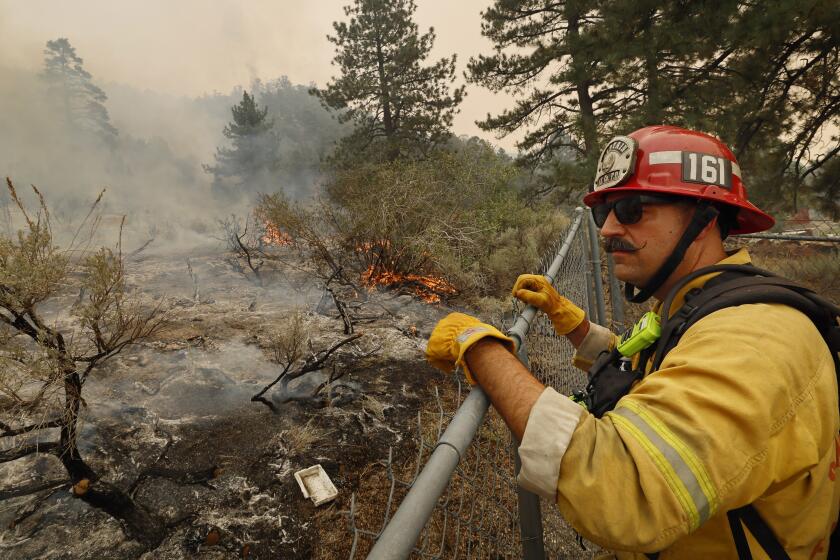FOCUS : Neighborhood’s Tale is of Two Cities
The residential southwestern corner of Costa Mesa is a neighborhood that can, and does, cause confusion, even for some people who live there. For in the less than one square mile bordered on the north and south by Victoria and 19th streets, respectively, on the east by Placentia Avenue and the west by the Santa Ana River are segments of two different cities.
Ask someone on the street if this is the Newport Terrace area and most likely he’ll reply, “You’re mistaken, this is Costa Mesa.” That’s largely true.
But a small pocket bordering on 19th Street adjacent to Talbert Regional Park is actually a part of Newport Beach. Newport Terrace is so far removed from the rest of Newport Beach and so nearly surrounded by Costa Mesa that it’s easy to understand why even the locals sometimes get confused.
Newport Terrace is a small pocket of relative affluence, boxed in by environs of need. As is true of many other areas in Orange County, a couple of blocks can make a tremendous difference in look and style.
Parts of the eastern section of the neighborhood are marked by the signs of urban wear, age, and in some cases, decay or neglect. Nearly two blocks of Victoria Street stand boarded. And according to the city there are no projects planned that will make any difference. Would-be front lawns serve as parking lots and crammed garages yawn lazily open, revealing their loads of every imaginable kind of household detritus.
Maybe it’s the oil wells along 19th Street, steadily pumping along their elevated terrain, with greenery all about, that are the tip-off of the differences to come. Balboa Boulevard, the aorta of Newport Terrace, may be a cul de sac, but it’s also the entry into a different kind of living. Shiny new, expensive cars and well-manicured lawns signal a life style unlike that to the east and north. Designer jogging suits seem the uniform of the day.
The 30-acre Newport Terrace Condominiums are the most prominent residential feature along Balboa. And in the unreal world of Orange County real estate, they represent something of an oasis of their own.
“This complex is the only property left in Newport Beach under $200,000,” says Fred Nicastro, broker for Century 21 in Newport Beach.
Prices start at $160,000 and, depending on the luxuries requested, level off around $190,000. At the heart of the complex is a 10-acre greenbelt with de rigueur amenities such as playground, barbecue and picnic areas, a full-size swimming pool, wading pool for children, and a Jacuzzi.
Bob Vollmer of Management Service Co., managers of the complex, explains that the condominiums were built in five phases, with the first completed in June, 1974, and the fifth on May 1, 1979. First-phase owners paid prices ranging from $37,450 to $43,950.
According to Corinne Schlott, president of the homeowners’ association, more than just the price of the units has changed.
“When I moved into my condo in 1985, there was a 55% tenant occupancy rate. Now owners are living in their properties, making it 55% owner-occupied. We attribute this change to the increase of value of these properties.”
Those owners and other residents are now waiting for the results of a survey seeking to determine their feelings about development of the land along 19th Street. Everyone was asked to state a preference: would residents like to see single-family homes, apartments, townhouses, a light industrial center, or would they prefer that the remnant wetland remain the way it is? Results are not yet available, according to Schlott.
The most striking natural attraction here is the Talbert Regional Park site at the western edge of the neighborhood. It is part of a 136-acre grassy and hilly plot the county purchased May 17, 1977, from the State Mutual Savings & Loan Assn. for $2.1 million, according to Grace Secketa of the program planning division of the Environmental Management Agency--Harbors, Beaches and Parks. Some of the area south of Victoria Street will remain wilderness, but exactly which areas and how much is the subject of a study now in progress and scheduled to be completed in mid-1990.
Although the site is not yet ready for public use, it is sure to become a considerable lure for neighborhood residents and naturalists. Its grove of mature willow trees (the biggest in the county), large pond and wetlands provide a haven where egrets and great blue herons live and breed.
It is a place where the two cities will be able to come together, yet not collide.
Population Total: (1988 est.) 3,631 1980-88 change: +7.0% Median Age: 32.2 Racial/ethnic mix: White (non-Latino), 81%; Latino, 14%; Black, less than 1%; Other, 5%
By sex and age: MALES Median age: 31.5 years FEMALES Median age: 33.0 years
Income Per capita: $18,600 Median household: $46,772 Average household: $47,360
Income Distribution: Less than $25,000: 22% $25,000-49,999: 32% $50,000-74,999: 30% More than $75,000: 16%
More to Read
Sign up for Essential California
The most important California stories and recommendations in your inbox every morning.
You may occasionally receive promotional content from the Los Angeles Times.










